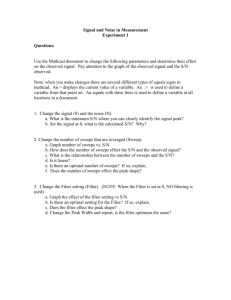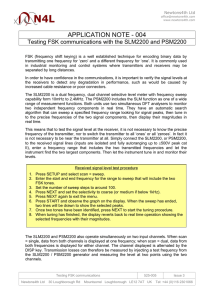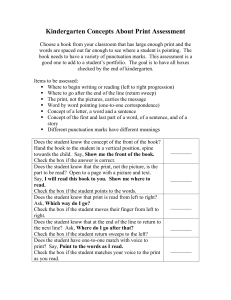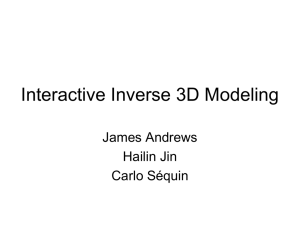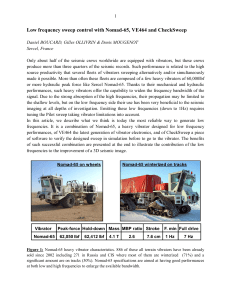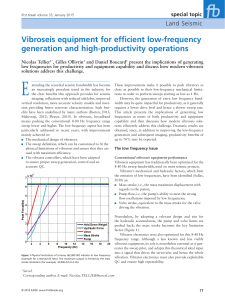Optimizing the generation and QC of low-dwell... Jun 17, 2014
advertisement
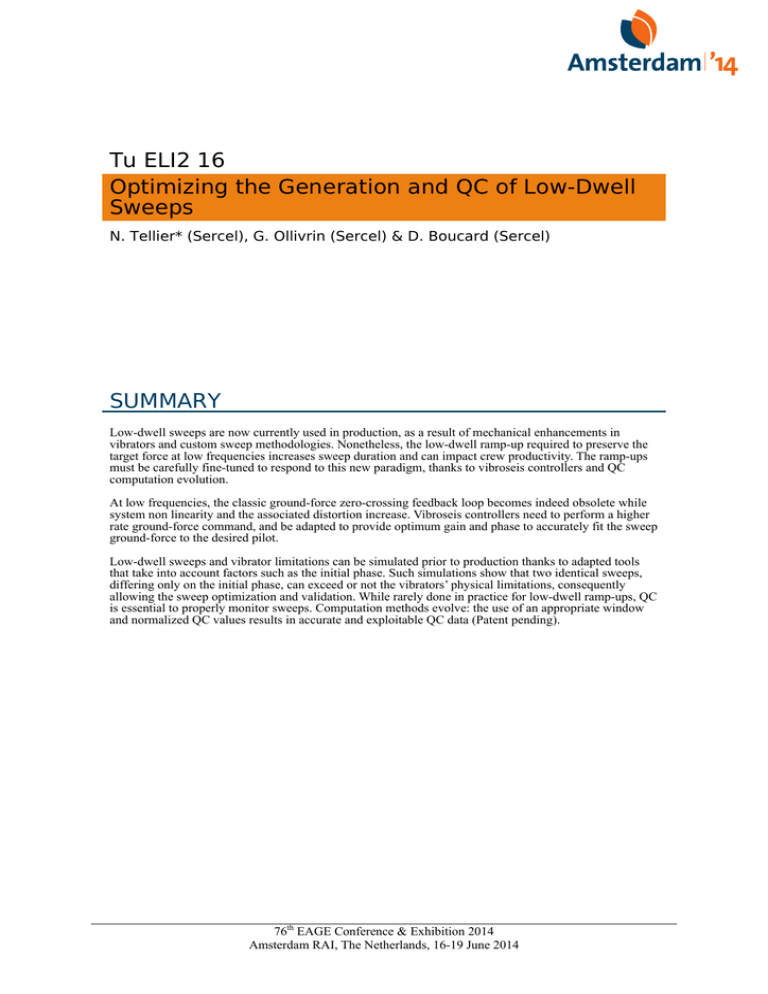
Tu ELI2 16 Optimizing the Generation and QC of Low-Dwell Sweeps N. Tellier* (Sercel), G. Ollivrin (Sercel) & D. Boucard (Sercel) SUMMARY Low-dwell sweeps are now currently used in production, as a result of mechanical enhancements in vibrators and custom sweep methodologies. Nonetheless, the low-dwell ramp-up required to preserve the target force at low frequencies increases sweep duration and can impact crew productivity. The ramp-ups must be carefully fine-tuned to respond to this new paradigm, thanks to vibroseis controllers and QC computation evolution. At low frequencies, the classic ground-force zero-crossing feedback loop becomes indeed obsolete while system non linearity and the associated distortion increase. Vibroseis controllers need to perform a higher rate ground-force command, and be adapted to provide optimum gain and phase to accurately fit the sweep ground-force to the desired pilot. Low-dwell sweeps and vibrator limitations can be simulated prior to production thanks to adapted tools that take into account factors such as the initial phase. Such simulations show that two identical sweeps, differing only on the initial phase, can exceed or not the vibrators’ physical limitations, consequently allowing the sweep optimization and validation. While rarely done in practice for low-dwell ramp-ups, QC is essential to properly monitor sweeps. Computation methods evolve: the use of an appropriate window and normalized QC values results in accurate and exploitable QC data (Patent pending). 76th EAGE Conference & Exhibition 2014 Amsterdam RAI, The Netherlands, 16-19 June 2014 Introduction Recent years have shown a growing interest in broadband sweeps, pushing the usual vibroseis 8-80Hz frequency range lower and higher. Numerous achievements have been done regarding the mechanical design of vibrators, particularly in low frequencies, as well as sweeps definition, which can be customized to fit the physical limitations of vibrators and use them with maximum efficiency. Vibrator controllers have evolved meanwhile, to ensure a proper sweep control and an accurate QC. Validating and optimizing the custom sweeps designed to exploit optimally vibrators is possible in the field prior to operations, using dedicated tools. Such improvements allow pushing vibrators as close as possible to their mechanical limitations, and eventually save operational time and improve vertical resolution. The advent of low-dwell sweeps Numerous achievements in the last years allowed lowering the vibroseis sweep start-frequency down to 1-2 Hz (Baeten, 2010). Designs of several vibrators were reviewed, mainly with a heavier mass, a higher hydraulic pressure, accumulators closer to the mass, and a larger mass stroke. Among these features the reaction mass stroke is the major limiting factor for low frequencies. In addition to these mechanical evolutions, sweep definition has evolved. Sweeps are now commonly customized for production, to fit physical limitations of the equipment, namely: hold-down weight, mass stroke, valve stroke, and pump flow. Two methodologies - EmphaSeis (J.Sallas, 2010), and MD-sweep (C. Bagaini, 2008) - allow pushing lower the current vibrators frequency range, usually down to 1 Hz, with nonetheless limited drive. This drive reduction implies that the time spent at low frequency is increased at minimum by the square of the reduction factor of the drive to preserve energy, the duration of the low-dwell ramp-up increasing significantly depending on the start frequency. Simulations displayed in Fig.1 show that a 1 Hz shift significantly increases the taper duration. Assuming a fixed 12 s sweep length, the time spent at full drive (7 to 85 Hz) varies significantly and thus the associated amplitude as seen on the amplitude spectra. Comparison is done with linear sweeps (in blue) starting from the same frequency and with the same duration at full drive as the corresponding non-linear sweeps. Their corresponding amplitude spectra lack the lowest frequencies and demonstrate the interest of using non-linear tapers. Starting to sweep at very low frequency may be then quite penalizing for productivity. Reducing the lowdwell ramp-up time can be achieved using a vibrator dedicated to low frequencies, and low-dwell rampup can be monitored in an optimum manner thanks to adapted controllers, QC, and sweep definition. Generating optimal low-dwell sweeps Vibrators’ electronics were initially optimized to fit with the most commonly used ranges of frequencies, generally 8-80 Hz. To be fully relevant and correctly exploited, vibrators and sweep design improvements need to be accompanied by controllers’ evolution. The classic feedback loop that controls and corrects the phase only at the GF zero-crossing becomes inefficient at low frequency due to the increasing sweep period and to the noise level. Thanks to full digital control based on a numerical vibrator model (D. Boucard & G. Ollivrin, 2010) controllers’ servocontrol is designed to perform a pursuit command to drive every 0.25 ms the Ground-Force as close as possible to the Pilot. Since non-linearities are included in the vibrator model, the commands take them into account to provide a non-linear input that reduces harmonic distortion. This is critical at low frequencies, particularly below 3-4 Hz where all non-linearities and the associated distortion increase. However, because non-linear tapers decrease the sweep rate, correlation is able to reject this distortion at larger negative times. Gain and phase can be problematic in very low frequencies (<4 Hz), with notable discrepancies between desired signal and real output. Essential corrections on controllers in low frequencies were achieved, allowing high signal correlation, as shown on Fig.2. 76th EAGE Conference & Exhibition 2014 Amsterdam RAI, The Netherlands, 16-19 June 2014 Figure 1 Example of different low-dwell sweeps (green) designed for Nomad 65 and starting from increasing low frequencies (1-2-3 Hz from left to right) up to 85 Hz, compared with same full drive linear sweeps (blue) - Matlab simulation. Figure 2 Gain and phase correction on a 1-20 Hz window: the green curve after controller correction indicates a great improvement on sweep control in low frequencies compared to the blue curve – Field tests with Nomad-65 vibrators controlled by VE-464. Initial phase influence and the QC of low-dwell sweeps Custom sweeps designed for low-dwell optimization to fit to vibrators’ mechanical constraints can be accurately fine-tuned before starting field operations, and thus be validated for optimal production. 76th EAGE Conference & Exhibition 2014 Amsterdam RAI, The Netherlands, 16-19 June 2014 Simulations (Fig.3) have shown that two identical sweeps with different initial phases create different behaviors: a 0° initial phase custom designed low-dwell sweep may indeed reach vibrator limitations, while the same with a 90° initial phase would pass. Such pre-production precautions allow emitting a given sweep without drive reduction. Figure 3 Amplitude vs time comparison of the first oscillations of two identical sweeps (5-80 Hz, 10 s, 300 ms tapers, 80% drive), for two different initial phases (Matlab simulation). The sweep with an initial 0° phase depicted in blue reaches vibrator mass stroke limits while the initial 90° phase sweep passes with a reasonable margin. Vibrators limitations and initial phases can be easily simulated with tools such as Sercel’s CheckSweep, and different sweeps and vibrators compared in different domains. The benefits of custom broadband sweeps can thus be improved, allowing time-saving in low frequencies and an optimum fitting to vibrators’ physical limits. Low-frequency QC calculation evolved meanwhile. Due to the low and increasing drive, low-dwell QC’s are in practice difficult to interpret and poorly representative and exploitable. Using normalized QC’s as shown Fig.4, with the low-dwell ramp-up QC resized to the same scale as full drive QC allows performing an effective and legible QC from the start of the sweep. The common practice, consisting in averaging mass and baseplate accelerometers values on a 0.5 s window (2 Hz) to compute every 0.5 s a Ground-Force QC, does not allow several signal periods to be included in the QC computation, providing below 4 Hz values that do not reflect the real behavior of ground excitation. In practice low-dwell ramp-up QC is rarely done in the field. A new approach consists in defining larger computation windows. Simulations confirmed by field test displayed Fig.5 allowed defining an optimal compromise of overlapping 1s computation windows with QC value output every 0.5 s, too large windows producing irrelevant QC. Figure 4 Comparison of current and normalized low-dwell QC. Resizing values to the same scale as full drive avoid poor QC legibility and interpretation due to low amplitude - Sweep EmphaSeis 1-86 Hz, 12 s, 80%. Low-dwell ramp-up from 0 to 5.8 s. 76th EAGE Conference & Exhibition 2014 Amsterdam RAI, The Netherlands, 16-19 June 2014 Figure 5 Comparison of the common 0.5 s and 1s overlapping computation windows on QC (field tests) with normalized results. QC values are output every 0.5 s in both cases. Conclusion While phase and gain controller corrections and accurate QC for low frequencies optimize the generation of low-dwell sweeps, pre-production custom sweep simulation and initial phase setting allow using vibrators in an optimal way. Ramp-up length can then be reduced, hence a gain in operational productivity. As the industry trend is getting focused on broadband sweeps generation, similar issues are at stake for high-frequencies. Vibroseis controllers will accompany this new paradigm. References Baeten et al. [2010] - Low-frequency generation using seismic vibrators. 72nd EAGE meeting, extended abstract. Bagaini, C. [2008] - Low-frequency vibroseis data with maximum displacement Sweeps. The Leading Edge, 27, 582-591. Boucard, D. and Ollivrin, G. [2010] Development in vibrator control. Geophysical Prospecting, 58, 3-40. Sallas J.J. [2010] How do hydraulic vibrators work? A look inside the black box. Geophysical Prospecting, 58, 3-18. 76th EAGE Conference & Exhibition 2014 Amsterdam RAI, The Netherlands, 16-19 June 2014

